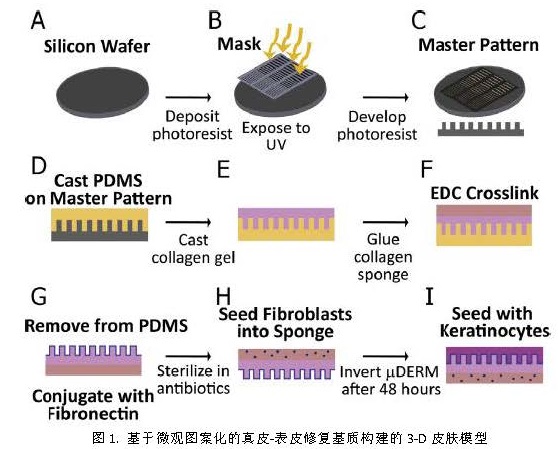微观图案化的真皮–表皮修复基质的构建及其功能化的微环境对表皮修复的影响

Acta Biomaterialia 9 (2013) 9474–9484
|
尽管人工皮肤移植物在一些经久不愈的创伤修复中取得了一定的成效,但是移植物成活率和稳定性仍广受关注。目前常用的多层皮肤移植物都缺乏真皮表皮结合部的具有特征性的微形貌。这些特征性微形貌有助于保持皮肤的机械稳定性,并为角化细胞发挥不同的生理功能提供相应的微环境,从而促进皮肤附件的形成和创伤的修复。 Amanda L教授团队开发出了以中新型的微图案化的真皮–表皮修复基质。这种基质模拟了上述复杂的微形貌,有效了促进了表皮细胞的形态学发生。为了系统性地研究不同特征微形貌与角化细胞生理功能之间的关系,基于这种三维基质应构建了一种体外细胞培养模型。实验结果揭示了三种对于角化细胞功能具有调节作用的微环境特征:狭窄的微形貌有利于细胞增殖,宽阔的微形貌有利于基膜蛋白的合成,以及狭窄微形貌的基底部以及宽阔微形貌的角落处利于β1brip63+角化干细胞的富集。这一研究说明,通过改变微形貌特征可以有目的的促进皮肤修复和移植物发挥作用,具有特征性接合部微形貌的真皮–表皮修复基质对于下一代人工皮肤移植物的设计具有重要意义。而本实验中设计并制备的真皮–表皮修复基质可以进行3-D器官型培养以制备新型的组织工程皮肤移植物。 Although tissue engineered skin substitutes have demonstrated some clinical success for the treatment of chronic wounds such as diabetic and venous ulcers, persistent graft take and stability remain concerns. Current bilayered skin substitutes lack the characteristic microtopography of the dermal–epidermal junction that gives skin enhanced mechanical stability and creates cellular microniches that differentially promote keratinocyte function to form skin appendages and enhance wound healing. Amanda L and her group developed a novel micropatterned dermal–epidermal regeneration matrix (lDERM) which incorporates this complex topography and substantially enhances epidermal morphology. And they described the use of this three-dimensional (3-D) in vitro culture model to systematically evaluate different topographical geometries and to determine their relationship to keratinocyte function. The result identified three distinct keratinocyte functional niches: the proliferative niche (narrow geometries), the basement membrane protein synthesis niche (wide geometries) and the putative keratinocyte stem cell niche (narrow geometries and corners). Specifically, epidermal thickness and keratinocyte proliferation is significantly (p < 0.05) increased in 50 and 100 μm channels while laminin-332 deposition is significantly (p < 0.05) increased in 400μm channels compared to flat controls. Additionally, β1brip63+ keratinocytes, putative keratinocyte stem cells, preferentially cluster in channel geometries (similar to clustering observed in native skin) compared to a random distribution on flats. This study identifies specific target geometries to enhance skin regeneration and graft performance. Furthermore, these results suggest the importance of lDERM microtopography in designing the next generation of skin substitutes. Finally, the 3-D organotypic cultures on lDERMS will provide a novel tissue engineered skin substitute for in vitro investigations of skin morphogenesis, wound healing and pathology. (武振旭) |